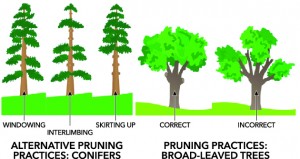 The most beautiful views in Washington State can be found on or near the Puget Sound shoreline. Attempting to maintain these views are one of the main reasons people cut or top trees. Cutting and topping trees can cause bigger problems than they solve. Alternatives are available.
The most beautiful views in Washington State can be found on or near the Puget Sound shoreline. Attempting to maintain these views are one of the main reasons people cut or top trees. Cutting and topping trees can cause bigger problems than they solve. Alternatives are available.
Benefits of retaining trees:
Trees help stabilize the land. Roots hold sand and soil in place, as well as take up large amounts of water that may otherwise flow down the face of the slope. Leaves and needles intercept and slow rain as it falls to the ground. These both help minimize the effects of erosion and the potential for slides. Trees, shrubs, and groundcovers help prevent some invasive plant species from becoming established.
Problems caused by topping or cutting trees:
Removing the top or crown of the tree lowers its vigor and leaves it susceptible to various diseases, funguses, and insect harm. This can ultimately lead to tree mortality and blowdown. Topping can also activate branch buds causing multiple shoots to pop up quickly below each cut in the tree’s effort to regain lost energy. The shoots can reach the previous height within two years, requiring continuous topping and associated dangers.
Alternatives to topping or cutting trees:
When it is absolutely necessary to prune a tree to preserve a view, there are a few recommended alternatives that cause the least amount of harm to the tree including windowing, interlimbing or skirting up. It is best to hire a professional arborist who has a trained crew with required safety equipment and liability insurance. This is especially good advice when working with tall trees or near a bluff. An arborist should be certified by the International Society of Arboriculture (ISA). Consider asking for bids, using the American National Standards Institute (ANSI) A-300 National Tree Pruning Standards. That way you are covered against damages and can compare bids easily. Remember that most local governments have some restrictions about tree removal within a buffer zone and there may be other restrictions including homeowner association rules or covenants.
There are big differences in how to prune a conifer and a broad-leaf tree. It is important when pruning a conifer, to retain at least 60% of its crown to keep it healthy. When conifer limbs are cut to open a view, that view will always be preserved, as the limbs maintain the same distance from the ground as the tree grows. When the tree increases in height, the growth is always at the top of the tree. The trunk may increase in girth, and the limbs may become thicker and longer, but they maintain the same height from the ground. Pruning of broad-leaf trees is time-consuming and difficult because they can re-sprout easily.